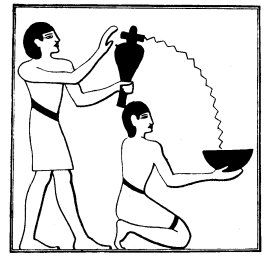
Masonic, Occult and Esoteric Online Library
The Liturgy of Funerary Offerings
By E. A. Wallis Budge
The Fourth Ceremony
The first ceremony removed evil or sin from the body of the deceased, the second gave it warmth, and the third restored to it the humours which had been expressed from it. For the fourth ceremony the SEM priest dissolved five grains of incense made from the salt deposits near the city of Nekheb, i.e., "Incense of the South," in a libation vase of water, and, having poured it into a vessel, walked with it four times round the mummy or statue, and sprinkled it each time. The name given to this libation water is "Semman," and of the five grains of salt, or alum, which it contained, one was for Horus, one for Set, one for Thoth, one for Sep, and one for Osiris, that is, for the deceased himself. Whilst the SEM priest walked round the statue the Kher heb said the following words four times:--
"[Here is] Semman! [Here is] Semman!
"Open thy mouth, O Unas, and taste thou the taste thereof in the halls of the god, for Semman is the emission of Horus, for Semman is the emission of Set,

The Sem priest pouring water from a libation vase into a libation bowl held by a ministrant.
for Semman is the stablisher of the heart of the two Hawk-gods (i.e., Horus and Set). Thou art cleansed with hesmen (natron), and thou art like unto the followers of Horus."
The libation thus poured out either represented the essence of Horus and the essence of Set, which was the source of the strength of their hearts, and the substance which gave them life, or was believed to be transmuted into that essence through the words of power spoken by the Kher heb. The power of the Semman water was great, for as soon as it touched the face of the deceased his mouth was opened, and he was able to taste the emission, or life essence, of Horus and Set. Having tasted it, his whole being was changed, and he became a new creature, and henceforth he was a counterpart of the Shemsu Heru or "Followers of Horus." The Horus here referred to must not be confounded with the twin-brother of Set. The Horus who is always associated with Set is "Horus the Great," or "Horus the Elder," the Haroeris of the Greeks, but the Horus mentioned in the Liturgy in connection with "Followers" is "Horus, the son of Isis."
The "Followers of Horus" were a group of beings who were closely connected with Osiris, and having "followed" him in this world they passed after him into the Other World, where they became his ministrants and messengers, partaking of his immortal nature, and sharing his life. Horus the Elder was "followed" by a group of beings also, but these were of a totally different character, for they were called "Mesentiu," i.e., "workers in metal," or "blacksmiths." In some texts the followers of Horus, the son of Isis, are identified with the metal-workers of Horus the Elder, and it is possible that this is the case in the Liturgy. On the other hand, the deduction to be made from our text seems to be that the essence of Horus and Set introduced into the body of the deceased changed his nature into theirs, while the cleansing with natron made him a counterpart of the followers of Horus, the son of Isis. He thus possessed the nature of Horus, the oldest god of heaven, and the nature of a "follower" of the son of the man Osiris, who rose from the dead and became the ever-living god and judge of the dead.
